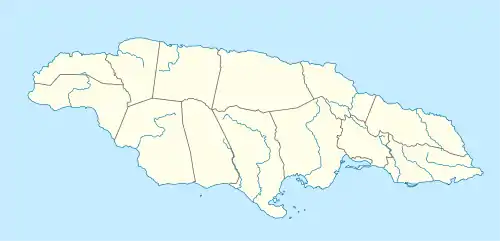Nanny Town | |
|---|---|
 Nanny Town | |
| Coordinates: 18°04′06″N 76°31′27″W / 18.0683°N 76.5242°W[1] | |
| Country | Jamaica |
| Parish | Saint Thomas |
| Founded | c1700 |
| Destroyed | 1734 |
| Founded by | Nanny |
Old Nanny Town was a village in the Blue Mountains of Portland Parish, north-eastern Jamaica, used as a stronghold of Jamaican Maroons (escaped slaves). They were led in the early 18th century by an Ashanti escaped slave known as Granny Nanny, or Queen Nanny. The town held out against repeated attacks from the colonial militia before being abandoned in 1734.[2]
Origins
One story is that Granny Nanny was born in what is now Ghana, West Africa, as a member of the Ashanti nation, part of the Akan people. Allegedly, she was enslaved, along with her five "brothers-in-arms", and brought to eastern Jamaica. She and her five "brothers", Cudjoe, Accompong, Johnny, Cuffy and Quao, quickly decided to flee the oppressive conditions of the sugar cane plantations to join the autonomous African communities of Maroons which had developed in the mountains.
These communities of Free black people in Jamaica originated from people formerly enslaved by the Spanish, who had refused to submit to British control. The Maroons of Nanny Town claim descent from escaped African slaves and Taino men and women.[3]
The Maroon communities grew as many more slaves escaped the plantations and joined them. Angered by continued raiding of plantations and armed confrontations, the colonial government mounted the First Maroon War of the 1730s in an effort to defeat and capture the runaway slaves.[4]
One story is that Nanny and her "brothers" split up in order to continue the resistance to the plantation slave economy across Jamaica. Cudjoe went to Clarendon, where he was soon joined by about a hundred Maroons from Cottawood; while Accompong went to St. Elizabeth, where a Maroon community was later named for him. Nanny and Quao made their way to Portland and the Blue Mountains.
A more likely origin for the Leeward Maroons occurred in 1690, when there was a Coromantee rebellion on Sutton's estate in western Jamaica, and most of these slaves ran away to form the Leeward Maroons.[5] Cudjoe is probably the son of one of the leaders of this revolt.[6] While Cudjoe emerged as the leader of the Leeward Maroons of the west, Nanny came to prominence as one of the main leaders of the Windward Maroons of the east.
First Maroon War
By 1720, Nanny and Quao had organized and were leading the settlement of Windward Maroons; it was known as Nanny Town. Nanny Town was organized similarly to a typical Ashanti tribe in Africa. After the First Maroon War, a deed from the colonial government granted Nanny more than 500 acres (2.4 km2) of land where the Maroons could live and raise animals and grow crops.[7]
In addition to what they raised and produced, the Maroons sent traders to the coastal towns to exchange food for weapons and cloth. During the First Maroon War, the Maroons of Nanny Town raided plantations for weapons and food, burnt plantations, and led liberated slaves to join them at Nanny Town.[8]
Nanny Town was an excellent location for a stronghold, as it overlooked Stony River via a 900-foot ridge, making a surprise attack by the British very difficult. The Maroons organized look-outs for such attacks, and warriors could be summoned by the sound of a horn called an abeng.[9]
Granny Nanny allegedly freed more than 800 slaves over the span of 50 years. She also had a vast knowledge of herbs due to her role as a spiritual leader. However, during the First Maroon War, and especially between 1728 and 1734, the British attacked Nanny Town time and time again, but each time the colonial militias captured and occupied Nanny Town, the Windward Maroons regained it shortly afterwards. This was accomplished due to the skill of the Maroons skilled in fighting in an area of high rainfall as well as disguising themselves as bushes and trees. The Maroons also utilized decoys to trick the British into a surprise attack. This was done by having non-camouflaged Maroons run out into view of the British and then run in the direction of the fellow Maroons who were disguised, leading the British into ambushes time and time again.[10]
After another Windward Maroon leader, Quao, signed the treaty of 1740 with the British, the Windward Maroons split up. Quao's supporters moved to what later became known as Crawford's Town, while the Maroons of Nanny Town relocated to Moore Town.
Leaders of Nanny Town
1720s - 1750s Queen Nanny
1720s - 1750s Captain Welcome[11]
References
- ↑ "Reference | Atlases".
- ↑ Pariser, Harry S. Jamaica: A Visitor's Guide, 1995, pp. 235-36.
- ↑ Agorsah, E. Kofi, "Archaeology of Maroon Settlements in Jamaica", Maroon Heritage: Archaeological, Ethnographic and Historical Perspectives, ed. E. Kofi Agorsah (Kingston: University of the West Indies Canoe Press, 1994), pp. 180–1.
- ↑ Bev Carey, The Maroon Story: The Authentic and Original History of the Maroons in the History of Jamaica 1490-1880 (Kingston, Jamaica: Agouti Press, 1997), pp. 117-257.
- ↑ Edward Long papers, British Library, Add MS 12431, folio 71.
- ↑ Richard Hart, Slaves who Abolished Slavery (Kingston, Jamaica: University of the West Indies Press, 2002), p. 43
- ↑ Edward Kamau Brathwaite, Wars of Respect: Nanny, Sam Sharpe and the Struggle for People’s Liberation (Kingston: API, 1977), p. 10.
- ↑ Carey, The Maroon Story, pp. 117-257.
- ↑ Carey, The Maroon Story, pp. 117-257.
- ↑ Carey, The Maroon Story, pp. 117-257.
- ↑ Michael Siva, After the Treaties: A Social, Economic and Demographic History of Maroon Society in Jamaica, 1739-1842, PhD Dissertation (Southampton: Southampton University, 2018), p. 272.